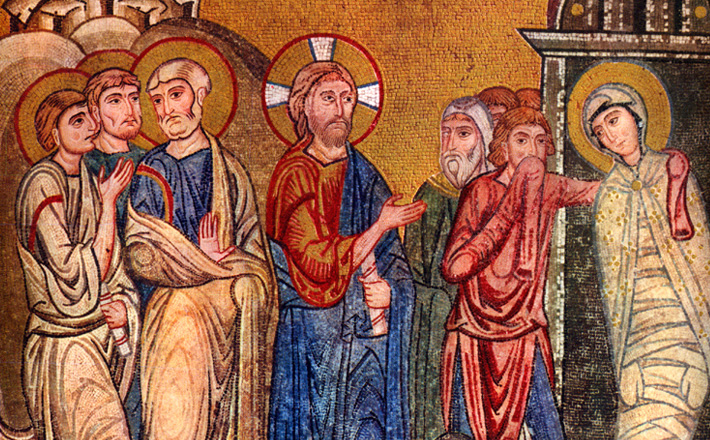Commentary on John 11:1-45
Stories of Jesus raising the dead appear in all the Gospels, but John alone includes the story of the raising of Lazarus.
As a story, it supplies a basic pivot point in the overall narrative: Jesus’ enemies shift from generalized opposition to a formal decision to have him killed. In that sense, then, the story signals the beginning of the end of Jesus’ teachings and signs.
However, consistent with John’s penchant for paradox, this “conspiracy” to kill signals God’s “conspiracy” to save: “‘You know nothing at all! You do not understand that it is better for you to have one man die for the people than to have the whole nation destroyed’” (verses 49b-50).
Biblical scholar Gail R. O’Day tells us that Caiaphas’ rebuke amounts to “the full truth … unwittingly told.”1
And the “shift” isn’t limited to the narrative horizon of John: as the assigned text in the lectionary for the Fifth Sunday of Lent, the story of Lazarus anticipates the events of Holy Week. Additionally, in Year A, the lectionary assigns John as the Gospel reading for four out of the five Sundays in Lent, supplying interpreters and congregations with a generous dollop of Johannine narrative.
One other note regarding the Johannine narrative deserves mention: its consistent emphasis on the personal encounter with Jesus Christ. Over and again, John presents Jesus as saying, in effect, “I, the one speaking to you, am he” (e.g., 15:1, 5; 10:7, 9, 11, 14; 6:35, 41, 51). Whereas the gospels of Mark, Luke, and Matthew prefer more indirect expressions of Jesus’ divinity through parable, John’s gospel surprises us with these frequent and startlingly personal expressions of self-disclosure.
As Raymond Brown notes, the absence of the “reign of God/heaven” language in John’s gospel is not an indication of some form of unearthly mysticism in John. Rather, John’s unwavering focus on the unity between God the Father, Jesus the Son, and the Advocate, the Holy Spirit, indicates the stress John places on community. Like the synoptic focus on the Reign of God, unity with Christ and the promised resurrection is not an other-worldly affair but a this-world promise: “Instead of entering the kingdom of God as a place, [John’s gospel asserts that we] need to inhere in Jesus to be part of the community.”2
The raising of Lazarus abounds with the personal character of the Johannine Jesus, in a sense intertwining the narratives of Jesus and Lazarus and, indeed, the whole community that believes in Jesus Christ, the Word made flesh. Lazarus, for instance, becomes a key character in the story of Jesus as one who, like the Samaritan woman and the the official’s son, leads many to faith in Jesus Christ (12:9, 11 cf. 4:39-42, 53b). Additionally, like Jesus, Lazarus lives under the threat of death (12:10).
John extends that intimacy of testimony in undeniably communal ways: Lazarus is the brother of Mary and Martha; Mary, we are told by the narrator of John (referring to 12:1-7) will be the one who anoints “the Lord with perfume and wiped his feet with her hair” (11:2); Martha, for her part, was there too, serving everyone, including Jesus and Lazarus.
Interestingly, when Lazarus becomes ill, “the sisters” send Jesus a message and it is a message calling upon the intimate love of Jesus for the beloved: “‘Lord, he whom you love is ill’” (verse 3). It is in response to this heartfelt appeal that Jesus answers saying that this illness does not lead to death “rather it is for God’s glory, so that the Son of God may be glorified through it” (verse 4).
Jesus’ answer recalls his response to the disciples who asked about the origins of one man’s blindness (9:3). It is an answer captured in the African American church tradition, “Where the world places a period, God introduces a comma — suffering does not have the last word!”
Yet this text does differ from Jesus’ healing of the blind man: this lection assumes the deep knowledge of Jesus and Jesus’ knowledge of the community. Jesus’ response to the sisters includes his loving attachment to not only Lazarus, but also specifically Martha and Mary: “Accordingly, though Jesus loved Martha and her sister and Lazarus, after hearing that Lazarus was ill, he stayed two days longer in the place where he was” (verse 6).
Even though all this happens for God’s glory, his decision to remain two days longer is not a cold dogmatism. John’s testimony writes a “letter of affection” on the hearts of those who wait. Nevertheless, Jesus’ decision to stay “two days” longer causes consternation for not only the disciples, but also for Martha: “Lord, if you had been here, my brother would not have died” (verse 21).
This might be one place that interpreters want to linger, particularly if the faith community is struggling with untimely death or inexplicable suffering. Maybe modern communities of faith would not say it so baldly, but the pained accusation might surface: “If Jesus had been with us … but he wasn’t.”
Maybe this absence recalls Jesus’ other absence in 9:8-34, his longest absence in the entire gospel. Of course, if that is his longest absence in the absolute terms of chapter and verse, the longest by far consists in those “two days longer” — two days stretched into the irreversible terminality of a tomb.
One way to explore the sense of Jesus’ absence in relation to the life and struggles of the “beloved community” would be to turn to passages in John 14:15-27, 16:4b-15, 20:19-23, each of which include Jesus’ promise of the gift of the Holy Spirit.
The last passage is particularly striking since Christ enters a room locked with fear, a lock that was powerless to exclude the appearing of the risen Christ. Our fears and our sufferings may always seem to be impervious, implacable in their finality. Even so, John’s gospel witnesses to a Christ who not only “picks those locks” but renders them as meaningless as grave clothes are to the risen Christ.
Two related cautions with regard to John’s gospel and its personal characteristics bear mentioning: first, it should not be taken to be synonymous with the popular notion of “Jesus is my personal savior” rhetoric; second, we should not let “individualism” have its way with John’s Christology.
After Jesus calls Lazarus out of the tomb, Jesus says to everyone watching, “‘Unbind him, and let him go” (verse 44). He was “risen” but was he truly alive in his full humanity, as a joyful member of the beloved community? Being raised from the dead entails a community dedicated to loving one another in the liberating love of Jesus Christ.
During my stay with the Cherith Brook Catholic Worker in Kansas City, I helped as the community hosted showers and opened a clothes closet for people living on the street. Many entered the shower room waiting area looking beaten, tired, and as neglected as the urban cityscape itself. People avoided eye contact. Conversation was limited. But as each emerged out of the showers, clean and wearing a fresh set of clothes, a new life seemed to come into their eyes. They shone with the warmth of their humanity restored, shining with the luster of care and dignity.
What I witnessed, I suppose, was a little resurrection, a resurrection of a person in community and a community in a person.
Notes:
1 Gail R. O’Day, “John” in The New Interpreter’s Bible, Vol. 9: Luke John, ed. Leander E. Keck, et. al. (Nashville: Abingdon Press, 1995), 549.
2 Raymond E. Brown, The Churches the Apostles Left Behind (New York: Paulist Press, 1984), 87.


April 6, 2014